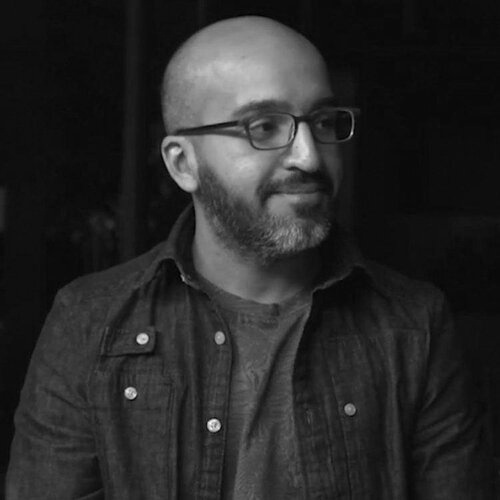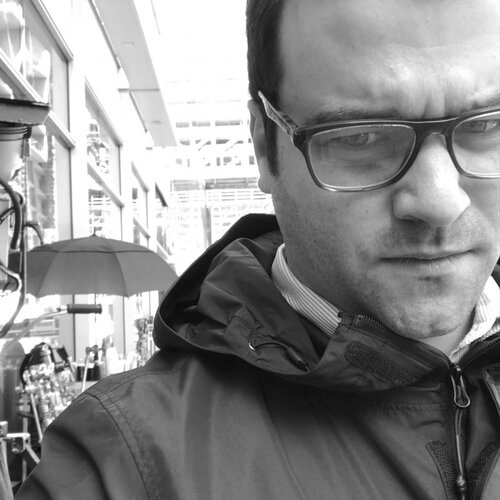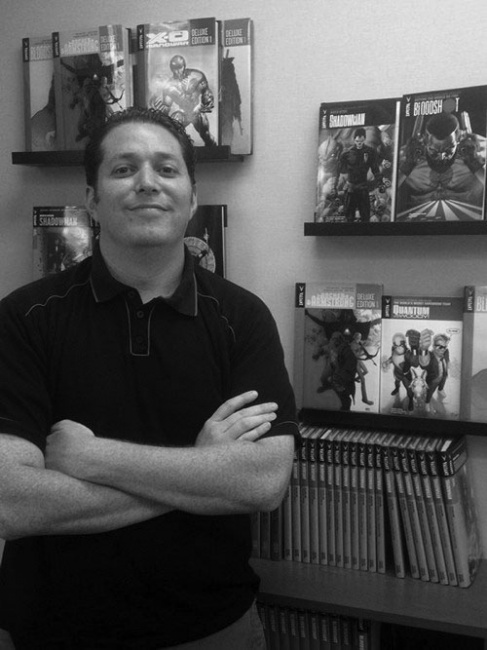Bad Idea is launching its first comics in March (see "Bad Idea at Nearly 250 Doors for Launch"), and we took the opportunity to interview three members of their executive team, Co-CEO and –CCOs Dinesh Shamdasani and Warren Simons, and Publisher Hunter Gorinson. We talked about the company’s long launch delay due to Covid, the role of comic stores, the Hero Trade story, and the company’s view of the market and its strategy.
ICv2: We want to go back to that period just as COVID was starting. You were about to launch and decided to pull back for almost a year (see "Bad Idea Reschedules Launch"). Tell us about that delay period and how that's brought you here.
Dinesh Shamdasani: We were very lucky, honestly. Had we launched, I think it would have been very difficult. We liked the release date that we had. So we said, let's put our flag in a similar date, one year from now. If things look good (I think we fully expected them to), we will move the date up. But better than moving it back every two to three months. Here we are one year later. This is the date that we're going to be launching on. I don't know if that's fortunate or unfortunate.
Hunter Gorinson: ENIAC #1 will come out on March 3rd. We're originally going to go to press on that book March 13, 2020.
Simons: From the perspective of the entire company, we've always been extremely bullish on the direct market. We have an enormous amount of faith in our partners in the retail community.
Whereas a bunch of companies were pausing production or putting pens down, we took the opposite tack. We knew that the direct market would be able to weather this storm. For us, it was a good opportunity to continue to build for a future that we knew was on the horizon, as opposed to pause production and get worried.
ICv2: You doubled production, but you've got a limit on how many books you put out each month. Basically, you were just extending the period for which you have content banked?
Shamdasani: It gave us a chance to not just fill the schedule, but also to do B‑Sides, something we announced recently (see "Bad Idea Reveals B-Side Stories"). For at least the first year of Bad Idea's publishing, every single issue we put out will have a short story in the back.
Gorinson: Hero Trade, the book that we secretly sent to the stores by Matt Kindt and David Lapham came out of that development period as well, of just the ideation of saying 'what can we do if Bad Idea is going to slip back in nine or 12 months with a formal launch? What can we do in the meantime to keep people on their toes?'
Warren Simons: Yeah and it also provided a greater scope of the freelancers that we were working with over the past year. We were able to recruit more, bring more people and get some exceptional work from our writers and artists, just really build stuff. I don't know if Lapham has drawn a story for another writer in 20 years. Having David draw Matt Kindt's script and love it and just absolutely knock it out of the park and just strike a little bit of oil in that capacity, it's always nice, especially for our first thing out the door.
ICv2: Warren, you said that you were bullish on the direct market. Bullish usually implies that you're seeing growth but the direct market really hasn't been growing. What are your assumptions about the comics market that are driving your strategy?
Shamdasani: There is growth. I think that it depends how you look at it. If you look at the direct market as a whole, every single store, then that's a question mark.
If you look at the top 10 percent of stores, top 20 percent, which is essentially what we've done at Bad Idea, is say 'Here are some admittedly egregious rules that you have to follow to be Bad Idea store and if you want to do that, we will double down with you. We will work harder too.'
We found that it is the majority of the shops that have come in are the bigger shops, the more robust ones, the ones that are innovative. Those shops are growing. Even in the pandemic, they've been growing. When Warren says that we're bullish, it's because there is this percentage that we deal with that are growing, and I think they're providing the example that a lot of the other stores are following and being able to build on top of as well.
Gorinson: One of the things that's very common for people who are entering the industry from the broader world of entertainment for the first time, is to take a look around at the direct market and say, "Why are we focusing so much on the direct market? We should be focused on digital. We should be focused on bookstores, etc."
It's fair to say that we respectfully disagree with a lot of those notions. We are firm believers in the fact that, if you want to build an audience in comic books, it has to start with comic book stores. They're the incubators of every lasting legacy in this business.
For us, I think everything Dinesh is saying goes hand‑in‑hand with that. There's a lot of very shrewd retailers out there. There's a huge audience for comics right now, a hugely passionate fan base, in a way, that has only been growing in recent years.
We see that as an opportunity to do something that can hopefully stand on its own two feet, but perhaps a band apart from what some of the conventional wisdom has been for the past several years.
ICv2: How does Bad Idea view the parts of the Direct Market, the readership side and the collectible side, and how is that informing your strategy?
Shamdasani: While the collector component is really robust, it's not what we're chasing. I will say (and this is where people get confused) we are very actively and consciously building a sense of FOMO. We feel like all comics, all entertainment, you need that.
There's so many options now. There's too much great TV. There's tons of comic books out there. Video games take up so much time; they're these giant, epic stories now. There's huge competition for that entertainment time‑space. We want to make the consumer, and the store, too, have to think about us, to be just a little annoying so we're on top of mind.
We don't see any of the money that Hero Trade has made on eBay. We gave them away, except for about 45 copies, and we sold those for three bucks apiece. That is our combined revenue on the Hero Trade.
ICv2: Could you briefly describe the Hero Trade project and how it turned out?
Gorinson: Sure. The Hero Trade is a 12‑page comic that we now know was written by Matt Kindt and illustrated by David Lapham that's a street‑level view of superheroes through the lens of crime fiction.
We were incredibly pleased with it when it came in. It's a wonderful, thought‑provoking short that we were originally planning to print as a B‑side story in one of our upcoming books. We got to thinking about it and eventually coalesced around the idea of pulling a little bit of a magic trick.
We surreptitiously packaged it and sent it to every one of the Bad Idea retailers at the time, which was about 150 or so. We made it appear as if it was a self‑published amateur comic by another publisher, so doesn't include Matt Kindt or David Lapham's names.
If you're not looking at it with a critical eye, it appears to be a self‑published comic that just arrived in the mail with a little note that says, "Hi. I'm a first‑time creator. This is my first comic. Hope you like it. If you like it, please order more and sell it in your store."
Some people immediately saw that and said, "Oh my God. It's David Lapham." A small minority. Another percentage of them said, "This is intriguing. I read it. I loved it. Would love to order more."
Others yet don't filter through their inbox in that way. People still get zines and stuff in the mail. It's still a common phenomenon among all the comic book retailers I've heard of. That went into their pile, or in some instances, the trash.
[laughter]
Gorinson: Once we revealed the trick, then, obviously, people went diving for them to see if they could find a copy in their store.
Simons: Part of the joy of it also is working with Matt and with David and putting together a book which is short. It's essentially about a superhero in the trunk. He's dead, and somebody's going around trying to sell his body parts. Just adding a little bit of a wrinkle and putting a little bit of a thumbprint on the type of books we like doing, that we enjoy doing, that are a little bit off what you might find from a Marvel or DC or Valiant book. It's a little bit strange, but there's a real hunger for owning really good stories, and I think this is one of them. I'm happy with how it turned out.
Shamdasani: The story really seemed to have an impact. People seemed to look at it and say, "What is this? No one else is publishing anything like this."
It very much is that Venn diagram of, as Hunter said, superheroes, Quentin Tarantino, Elmore Leonard, independent comics. It's a very unique tone, which is hopefully what we'll be as a publisher.
ICv2: You've just given the high‑concept description of what elements are included. That sort of talks about who you see as your consumer. Who is the consumer for Bad Idea comics?
Gorinson: For me, I feel like if you're someone who's in your comic book store on a regular basis, if you're someone who is loading up your pull list with books from Marvel, DC, Image, Dark Horse, if you're someone who's pouring over the Previews catalog curious about what the prevailing trends in comics are, who the hot creators are, etc., then Bad Idea is a place where you should be able to come and expect really, really, really high‑quality comic storytelling.
I personally feel like, if you're someone who checks all those boxes, if you're someone who's a die‑hard comics fan, you're probably the kind of person in your life who your friends and family are asking you for recommendations about movies, about TV. You're essentially, for lack of a better term, a pop culture influencer for your friends and family. You're steeped in this stuff.
If you're steeped in comics, then Bad Idea books are for you. We're trying to do something at a pretty high level. We're trying to do something that has a level of quality that hopefully will be self‑evident when people can pick up the books and feel them in their hands.
That extends from everything from the storytelling, to the way the books are designed, to the print quality we're trying to put into them. We really are building a love letter to the medium of comics, hopefully, each and every month.
Shamdasani: We hate to be so nebulous about our answer, but the truth is, we don't have to have a very clear answer like we did at Valiant or like other publishers do. We built a system in which we don't have to sell that many comics.
We've built a system where we've made the sacrifices where we don't need to sell 10, 20, 30, 50 thousand units of a book to make it viable for us.
Simons: With that comes a lack of intensity into the production process, where we don't need to scramble to ship 40, 50, 60 books a month, to ship 10 books a month.
We can drill down on the story, work with the creators, build something where, hopefully, when it does go out to the market, people receive it and read it and, if they can find it, respond to it and say, "Holy shit. What was that? This is the best comic I read this month."
It won't always be the case, but hopefully it'll be the case more times than not where the work that we're putting together, the final product will be a good, clean story, which is something that is totally dependent on the strengths of our medium.
Shamdasani: Yeah, and I'll give you some examples of how we're able to do that. The no variants thing ‑‑ you'd be surprised. Those variants cost a lot of money. When you're doing two, three variants per book and publishing 10, 15 books a month, that adds up. It's a lot.
Simons: They're also insanely labor‑intensive. If you're publishing six books, and you have four variants in each of them, that's basically a variant a day in the publishing cycle. Let alone, that's where the talent goes. That's where the colors go. That's where the production goes. That's where the logos go. It's an enormously time‑consuming process.
Shamdasani: I think I can also actually talk about another thing, about collections as well. That's something that Marvel years ago decided they were going to print to orders, not to inventory. It makes sense, because every publisher is sitting on seven figures of collections inventory. It adds up.
Even at Valiant, after just a few years of publishing those, we were sitting on millions of dollars of inventory. That's money that can go into building the books or money that allows you not to have to sell too many copies or have to make creative sacrifices. We prefer that.
There is a down side, of course, in that there are trade‑only readers. We're hoping that some of them will cross the chasm back into monthly comics, but again, it doesn't really matter to us if most of them don't.
ICv2: The last time we talked to you for an interview, it was Hunter and Dinesh at New York Comic Con 2019 (see "ICv2 Interview: Hivemind’s Dinesh Shamdasani and Hunter Gorinson"). At that time, you were talking about Hivemind. What's the relationship between Bad Idea and Hivemind, if any? Maybe you can clarify that situation.
Shamdasani: No relationship. Gorinson and I are involved both in Hivemind. We've, with the success of The Witcher, had to create a sister company, Allnighter. They're both arms‑length from Bad Idea.
I'm sure there'll be synergies down the road. At the moment, no direct or planned relationship. Just two fun things we're doing.
ICv2: That's a way to get at the broader question of, what are your plans for media exploitation for any of the comics that you're publishing?
Shamdasani: It's a part of the business now. There's nothing that we can do to avoid it. If we do our job, if we build good books people like, eventually, the fan base will grow to the place where it's one of our friends that's a writer or director or studio executive sees it in a store and likes it enough, they desire to make an adaptation. We'll field those calls as they come. We've already had a ton.

On the Covid Delay, the Role of Comic Stores, the 'Hero Trade' Story, the Bad Idea Strategy
Posted by Milton Griepp on January 22, 2021 @ 4:41 am CT






